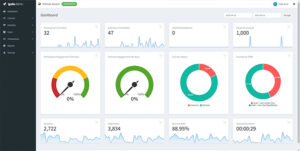Organizations that offer incentive programs must be able to measure, report, and justify a program’s existence. Ambiguous statements like, “It seems to be going well” will not fly when senior management begins to ask about a return on investment. Often discussed after a program has been completed, tracked metrics are key to proving an incentive program was successful. When evaluated before a program begins, these key metrics will shape and guide an incentive program’s lifecycle. Proving success can seem daunting, but you may find it easier than you think.
“No phase of program planning is more important, yet more often overlooked, than measurement.”
– Roger Stotz, Chief Research Officer, Incentive Research Foundation (IRF)
Analyzing programs using both hard (objective, measurable) and soft (subjective) metrics and driving home the program’s effect on performance and revenue helps ensure there is a budget for the program year after year. Without good reporting, a program may be quickly nixed the next time budget cuts are required. As we discuss the finer points below, we will go through the following outline to help you succeed with your program’s measurements.
1. THE BASICS
2. REPORTS
3. DECISION MAKING
1. THE BASICS
ENROLLMENT DATA
Collecting information about enrolled participants is critical for the design of your incentive program. For example, physical locations will be necessary for international incentive programs since award options will vary depending on the country due to availability and regulations. Also, tracked job titles will be helpful when you want to differentiate the influence of an incentive at different levels of the corporate ladder. And those examples are just scratching the surface.
To begin this process, program administrators will first need to define what type of information is required from each participant, and then an enrollment process should be created. We recommend that at least three types of data should be collected from all participants:
- Unique Identifier: You will need to be able to identify each participant with a field that has a unique value to them (Examples: Employee ID, Email Address, etc.).
- Demographic Information: This deals with physical location and a person’s role inside the company (Examples: Job Title, Department, Phone Number, Geographical Region, Address, etc.).
- Tax Reporting: Since tax reporting is required, sensitive information will need to be collected (Example: Social Security Number).
Next, you will want to consider the enrollment process and whether it should be automatic or manual. If administrators choose for participants to opt-in themselves, important and possibly sensitive information will need to be filed digitally. It could be possible that HR can release the required information; however, questions about privacy and security will need to be raised. Whichever way participant’s information is gathered, remember to keep the end in mind. How will your program use this data, and what types of reports will you want to create?
Lastly, we mentioned this earlier, but tax information will be important. Uncle Sam has some tax requirements for US participants that he feels strongly about. At the end of each calendar year, the taxable value of the incentive must be added to an employee’s W-2 or reported on a Form 1099-Misc for non-employee contractors. Incentive companies like Brightspot thoroughly understand the IRS rules regarding incentive awards. They can assist you with IRS compliance and calculate the lowest taxable values to save on taxes. If you would like more detailed information on incentive program tax rules, please check out our guide on Tax Rules for Incentive Programs.
POINTS & PERFORMANCE DATA
After solving the enrollment data process, you will need to discuss how points will function. Most companies will choose an incentive software platform, and this should have a strong scorekeeping engine to maintain scoring logic and points earned. These systems will verify requirements, calculate points, and update point totals without needing manual assistance. And, if you add enrollment data, program administrators will have tracking capabilities and be able to see earnings by sales rep, company, and geographical region thanks to demographic data. Other points of interest such as earnings by product line, SKU, date of sale, incentive offer, and others can also be collected and calculated inside an incentive platform. You can learn more about how incentive software is essential to a high-performing program in our overview of Ignite, our proprietary platform.
Data collected through participants’ actions or performance data can come from a CRM system (like Salesforce), an order management system, or an accounting system. However, if exporting from an external system is not an option, a claims submission process can be built from the ground up for the incentive program. Choosing this option has the added bonus of increasing engagement since each participant does the process. Essentially you build a portal or API that makes it easy for participants to import their performance data. And once you’ve selected a specific cadence for data imports (daily, weekly, monthly, etc.), you are well on your way to creating a great program.
After collecting this data, the next step will involve verifying its accuracy and ensuring it follows the incentive rules (data, products, conditions, etc.). Robust incentive platforms will qualify eligible data submitted using “business rules” technology. This electronic verification is often customized to the incentive sponsor’s requirements for available dates of sale, SKUs, geography, vertical market, authorized sellers, and other qualifying conditions. This helps avoid headaches from unintentional points being awarded for actions deemed irrelevant.
2. REPORTS
COMMON REPORTS
A baseline reporting system will need to be defined and implemented to demonstrate a strong program performance for management. A good incentive platform will empower program administrators to export detailed transactions for scheduled or ad hoc analysis.
These basic reports usually include:
- Enrollment Data
- Performance Data
- Progress Reports or Leaderboards
- Points Earned
- Points Redeemed
REAL-TIME INSIGHTS
In addition to performance data, Brightspot and other incentive software programs offer a dashboard to consolidate various program components. This allows for real-time access to current program statistics, giving users and administrators a bird’s eye view of the data that powers their program. Some example data points include:
- Engagement trackers
- Payout amounts
- Redemption numbers
- Activity status
- Activity status details
- And more
Users who receive access to these features will see precisely where their programs stand with these “quick hit” data points.

Brightspot’s Ignite Software Dashboard
PROGRESS REPORTS & LEADERBOARDS
Incentive platforms can track an individual participant’s performance, and this allows administrators to issue progress reports and leaderboards. When correctly handled, these status updates spur healthy competition and increase sales. With sales incentive initiatives, leaderboards are essential, and highlighting a person’s performance provides needed recognition to high-caliber team members. The leaderboard you choose should be driven by the incentive program and themed by the program’s graphic design. There are many ways to showcase your top talent, but several popular choices include featuring them by region, time frame, points, or something related to the program.
3. DECISION MAKING
ASSESSMENT & ADJUSTMENT
At the mid-point of the program, we recommend using the available reporting to analyze what has been working and what has not. Have the incentives issued been able to deliver the results desired? Is there a popular incentive in the incentive roster? Brightspot recommends a scheduled program review for any ongoing program (annual, quarterly, etc.) as it is critical to discuss performance and evaluate data for any upcoming program. After analyzing the reports, consider what adjustments or improvements should be made. Often, we will see a program lagging due to several common factors:
These basic reports usually include:
- Bad Communication: More communications or promotions may be needed to build awareness or understanding of the program.
- Complicated Program Rules: Overly complicated program rules lead to confusion. Take the time to clarify the rules with your participants or simplify the incentive structure.
- Bored Audience: Add a spiff or overlay contest with an exciting prize to draw extra attention back to the program.
Warning! Be careful not to change your incentive program too much. Participants are not as familiar with the program as you, and something that makes sense to you may not make sense to your participants. Will it be easy to explain the change? Handle any changes with care and much consideration.
Also, don’t forget to look at points that have already been earned on top of those also redeemed. This can highlight which awards are working and which are not. Comparing points earned vs. redeemed is an effective and transparent way to track and predict program performance.
ROI
With today’s complex business structures, multiple sale types, and various marketing tactics, one could undoubtedly be overwhelmed with how to calculate ROI for an incentive program. Easily one of the biggest challenges comes from making judgment calls on attributing success to each tactic.
During a program review, analyze the program’s success by reviewing “hard metrics.” This data can be pulled from some of the common reports outlined earlier. This means evaluating performance data and points to identify direct correlations to sales revenue. When you plot different points across a timeframe, you can identify trends and explain why sales and profits increased. You will see a story unfold and be able to explain how the program influenced desired behaviors. This will ultimately provide you with the talking points to present a return on investment and very likely secure another successful incentive program initiative for the future.
ROO IS THE NEW ROI
While ROI is steadfast as the key indicator for success, ROO (return on objectives) has surged in popularity. ROO refers to the use of non-sales metrics to gauge the impact of a program. It is objective by name and definition, so it helps to target organizational goals and measures desired actions or behaviors.
These types of measurements may include:
- Program Satisfaction
- Employee Morale, Engagement, and Retention
- Partner Engagement
- New Customers and Customer Loyalty
- Education and Certifications
- Sales Enablement
Although unlinked to revenue, these stats provide residual benefits that could greatly impact an organization. For instance, employees may think it is time to look for another job if morale is low. An unhappy sales team equals unhappy revenue figures.
SEEK IMPROVEMENT
Program administrators should often ask, “What does it mean? What’s the next step? Where can we improve?” When it comes to fine-tuning a program, we like to take it a step further and take a deep dive into HOW the data was received. This means it could have been manually submitted, or it could have been imported directly. We sift through this process thoroughly, and after this analysis, we move to asking some common questions that help us discover actionable data points. These include:
- What offers are being claimed the most often? Least?
- What products and deals drive the most revenue? Margin?
- How many users have logged in during the last quarter?
- Is deal size growing? Is the number of transactions increasing?
The answers to these questions diagnose the areas for continuous improvement and serve to anticipate the unspoken needs of participants, the channel, and the overall program. We highly recommend these steps for anyone seeking to enhance their program since we are firm believers in constantly seeking improvement.
DRIVE RESULTS WITH INCENTIVE SOFTWARE
Behind the scenes of each incentive program lies the backbone of its success, an effective incentive platform. Brightspot exists to provide a top-to-bottom solution for creating, launching, managing, and reporting on the perfect incentive program. Ignite is Brightspot’s flexible platform that enables a quick launch and a robust technical option for scalability and customization. We help drive results and track progress every step of the way with our proprietary Ignite software platform. Want to learn more about our offerings? Contact us today!






